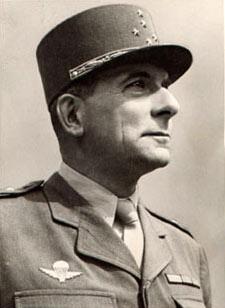Jean-Marie de Lattre de Tassigny

Born on the 2nd February 1889 in Mouilleron-en-Pareds, in the Vendée, into an old aristocratic family from French Flanders, Jean-Marie de Lattre de Tassigny received a first class education at Saint Joseph's college in Poitiers.
Military career
From 1898 until 1904 he trained at the naval School and was accepted by Saint-Cyr in 1908. He took classes at the 29th Dragoons in Provins. He was a pupil at Saint-Cyr from 1909 until 1911, in the "Mauritania" class where he came fourth in his year. In 1911 he attended the school of cavalry in Saumur. In 1912 he was posted to the 12th Dragoons in Pont-à-Mousson and then to the front. During the First World War he was captain of the 93rd infantry regiment and ended the war with 4 injuries and 8 commendations. He was then posted to the 49th infantry regiment in Bayonne from 1919 to 1921. In 1921 he was sent to Morocco to the 3rd bureau and to the headquarters for the Taza region until 1926. From 1927 to 1929 he took courses at the French war college with the 49th class. He married Simone de Lamazière in 1927 and they had a son in 1928. In 1929 he became Head of Battalion to the 5th infantry regiment at Coulommiers.
In 1932 he was promoted to the high command of the army and then to that of General Maxime Weygand, Vice-President of the Upper War Council, as Lieutenant Colonel. In 1935 he became Colonel, commanding the 151st infantry regiment at Metz. Between 1937 and 1938 he took courses at the centre of higher military studies and in 1938 became the governor of Strasbourg's Chief of Staff.
Second World War
Promoted to Brigade General on the 23rd March 1939, by the 2nd September 1939 he was Chief of Staff of the 5th army. On the 1st January 1940 he took command of the 14th infantry division, which he commanded during the confrontations with the Wehrmacht at Rethel, where his division held out heroically, as far as Champagne and the Yonne, miraculously maintaining its military cohesion in the middle of all the chaos of the debacle. From July 1940 until September 1941, he was deputy to the Commanding General of the 13th military region at Clermont-Ferrand and then became Division General, commanding troops in Tunisia until the end of 1941. He subsequently commanded the 16th division at Montpellier and was promoted to General of the army corps. When the Free Zone was invaded by German troops, he refused to obey the order not to fight and was arrested. He was sentenced to 10 years in prison by the State tribunal of the Lyon section. Managing to escape from Riom prison on the 3rd September 1943, he went to London and then on to Algiers, arriving on the 20th December 1943, after promotion to the rank of Army General by General de Gaulle on the 11th November 1943. In December 1943 he commanded the B army, which became the first French army. He landed in Provence on the 16th August 1944, took Toulon and Marseille, headed back up the Rhone valley and then the Rhine, liberating the Alsace, entering Germany and advancing as far as the Danube. He represented France at the signing of the armistice on the 8th May 1945 in Berlin at the headquarters of Marshal Joukov.
After the war
Between December 1945 and March 1947, he was Inspector General and Commander in Chief of the army. In March 1947 he was Inspector General of the army and then Inspector General of the armed forces. From October 1948 until December 1950, he was Commander in Chief of the western European armies at Fontainebleau. He became High Commissioner and Commander in Chief in Indochina and Commander in Chief in the Far East (1950-1952) and established a national Vietnamese army. Exhausted by the strenuous workload to which he had been subjected throughout his career, which had not been helped by the injuries he had received in 1914, deeply affected by the death of his son Bernard, killed during the Indochina campaign and suffering from cancer, he died in Paris on the 11th January 1952, following an operation. He was posthumously promoted to the dignified position of Marshal of France at his funeral on the 15th January 1952. He is buried in his home village of Mouilleron-en-Pareds.

